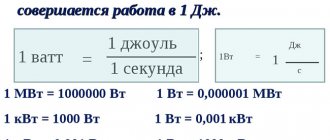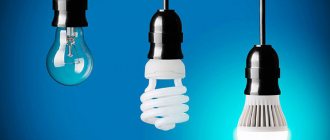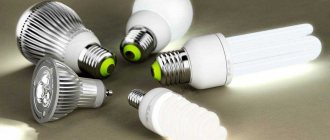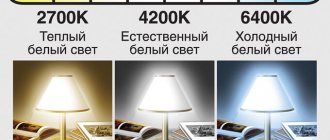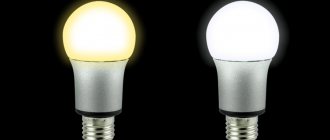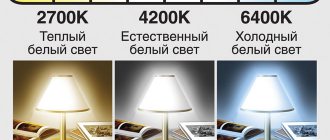When choosing a fluorescent (usually called energy-saving) or LED lamp, many buyers are guided by the inscription on the packaging indicating the power of an incandescent light bulb it can replace. But this approach is erroneous, since manufacturing companies often overestimate the technical indicators of their products.
So what is the right thing to do and what to pay attention to when choosing an LED lamp instead of a burnt-out fluorescent or incandescent lamp?
general information
The white LEDs that are used today first appeared in 1996. However, only in 2005 they began to be used specifically as a lighting source. This type of light bulb is energy saving.
The luminous power of LED lamps is their main characteristic . It shows the energy efficiency of this type of lighting. The power of LED lamps is measured in watts. Manufacturers are gradually trying to increase the quality of the glow without changing their power. That is why the consumer receives a high-quality lighting source, but at the same time saves energy. For comparison, you can use an incandescent light bulb with a rating of 100 W. A LED with the same level of illumination will have only 12 W.
Types of diode light bulbs
The first criterion for dividing is the material of the case:
- Glass (frosted or transparent);
- Aluminum;
- Plastic;
- Ceramics.
By type of base:
- Screw (letter designation – E);
- Pin (letter designation - G).
On the base, in addition to the letter indicating its type, numbers are indicated that indicate for the first type the diameter, measured in millimeters, and for the second type this is the length between the pins.
Thus, the following types of LEDs can be distinguished:
- E14 (bulbs with a smaller diameter base, suitable for some lamps);
- E27 (regular, which are suitable for installation, for example, in chandeliers, where the socket is designed for incandescent light bulbs);
- G4 (can be used, for example, to illuminate pictures).
- GU5.3, G9 (replacement for halogen bulbs);
- GU10 (used for built-in lamps that serve as lighting, as well as in hoods);
This list shows only the main types.
Power table for LED lamps
Depending on the type of paw on the base, the indicators may be as follows:
It is clear from the table that higher power LED bulbs produce greater luminous flux. Depending on the power of LED lamps, their purpose changes. An E27 or E14 light bulb with a power of 5 W will be sufficient for the home. But for a large workshop you will need a stronger light source.
At the beginning, the power of LED lamps for the home is indicated in the table. However, this is not the minimum value for this type of lighting. There are diode lamps with a rating of 2 W. And the maximum power of LED lamps can reach up to 180 W.
What is a lumen
When choosing light bulbs, power is not the main indicator, since it shows how much energy the device spends. For example, a 60W device is weaker than one rated at 100W. To find out the intensity of light, you need to define a unit of measurement such as Lm. Lumen is a more accurate indicator, since light bulbs with the same power, but different levels of efficiency (efficiency) and spectral composition, emit light of different intensities.
Lumens measure the amount of light that a lighting fixture emits in different directions. This physical quantity began to be used in the middle of the 20th century.
To determine the degree of illumination of a lamp, 2 important values are used - lumen and lux.
Important! Lumen is a value that represents the total luminous flux that a lighting element emits in different directions. Lux (Lx) demonstrates the amount of light that falls on 1 m² of surface. That is, the higher the Lm, the more illuminated the surface, and the greater the number of Lm, the brighter the lamp.
Thus, to evaluate the efficiency of a light source, you need to use the following formula: 1 Lx = 1 Lm/m². For example, if a lamp with a luminous flux of 100 Lumen illuminates 1 m², then the illumination will be equal to 100 Lux. If the same device is used on an area of 10 m², the degree of illumination will decrease. During calculations, it is necessary to take into account the luminous flux, which is directed in all directions.
LED bulbs emit directional light, unlike devices with incandescent filaments and fluorescent ones, which shine evenly in all directions. To ensure that the surface is equally illuminated, you need to purchase LEDs with lower brightness.
Correspondence of the power of LED lamps to other types of lighting
From the table we can conclude that diode lamps are less energy-consuming compared to others. With different powers, the luminous flux of LED lamps and the other two types remains the same.
Thus, the rated power of LED lamps that need to be installed in the house can be calculated based on the table above. Also on the packaging of some light bulbs there is information about equivalent indicators. For example, a 5 W LED light bulb corresponds to a 40 W incandescent light bulb. Moreover, in both cases they will have the same glow.
Design
In general, a compact luminescent device consists of a bulb, an electronic board and a base.
Fluorescent lighting device
Sealed glass tube
The flask is a hollow type (or a sealed curved glass tube), which is connected with its terminals to an electronic board.
Types of flasks
Inert gas inside it and mercury vapor
Such a tube is filled at the factory with special gases (mercury vapor, argon and other gases). Such gases are very dangerous for humans if the device is damaged, and it is important to be careful when using fluorescent energy-saving devices.
Phosphor layer
The body of the gas-discharge device is coated with a special composition - phosphor (a mixture of calcium halophosphate and other elements).
An electric discharge creates ultraviolet radiation in a flask with mercury vapor, which is changed into a visible light flux using a phosphor.
Electronic board
The electronic board in gas-discharge devices is an important component, and the service life and quality of its glow depend on the quality of its assembly. Structurally, such a board consists of:
- The thermistor is an element that ensures a smooth start of the device and helps to warm up the lamp coils without blinking.
- The starting capacitor is the element that directly starts the device.
- Filters - protect the electronic board from interference;
- Capacitive filter - reduces pulsations and eliminates flickering of the device;
- Current-limiting choke - stabilizes the device and limits the current;
- Fuse - protects the device and turns off the lamp when overloaded;
You may be interested in: Features of connecting a chandelier
Principle of operation
A voltage is applied to the dinistor, which forms a pulse. This pulse arrives at the transistor and causes it to open. As soon as the start is made, the circuit is closed by the diode bridge, the capacitor is charged and re-opening does not occur.
The transistor operates on a transformer with several windings and a ferrite core. Voltage is applied to the transformer filaments and a glow appears in the bulb. In this case, the voltage reaches a high value (up to 600 V).
When the inert gas in the flask is completely ionized, the voltage is reduced to sufficient to maintain the lamp glow, which ensures the energy-saving properties of the lighting device.
Selecting a lighting fixture
Colorful temperature
Possible indicators:
- From 2700 to 3000K;
- 4000K;
- 6500K.
This concept is also one of the characteristics of diode lamps. It is measured in Kelvin (K). The color of the glow depends on this indicator. For example, a color temperature value between 2700K and 3000K indicates that the light will be yellowish.
Lamps with a color temperature of 4000K have a white glow. This type of light is usually used in shopping centers. And if the indicator is 6500K, then the light will be cold white. Such lamps are used only in industrial premises.
For the home, lamps with a color temperature level of 2700K – 3000K are best suited.
Ripple factor
This parameter (Kp) is not often indicated on the lamp packaging, but this does not make it any less significant. The pulsation coefficient can affect a person’s well-being. It is determined using an oscilloscope: the amplitude of signal oscillations on the LED must be divided by the output voltage of the power supply. High-quality lamps have a coefficient of up to 20%, and LEDs with a current driver - 1%.
Life time
Despite the low power consumption of LED lamps, their service life is an important point. After all, if they break down quickly, then there is no point in purchasing them, since there will be no energy savings.
When purchasing diode light bulbs, the buyer is given a guarantee for the product. Typically the warranty period is from 3 to 5 years. This is already a good indicator. However, based on statistics, the service life is approximately 50 thousand hours, which corresponds to 6 years. However, many users note that the quality of the glow deteriorates over time.
Pros and cons of purchasing this type of light bulbs
Positive and negative aspects can be assessed using the following indicators:
- Price;
- Dimensions;
- Directional light;
- Ripple.
As for the first characteristic, we can say that the cost can be twice as much as for a regular light bulb. This is the main disadvantage of the product. However, it is worth considering that due to energy savings, the cost of the product will pay for itself.
When replacing a light bulb, you need to consider its size. LED dimensions may be larger compared to conventional ones. This may affect the appearance; the light bulb may stick out strongly from the lamp or may not fit there at all.
LED bulbs have a slightly different direction of light, which may be unusual at first. Their side lighting is poor.
The positive thing is that there is no light pulsation. However, not all light bulbs have this phenomenon. You need to purchase a quality product to avoid pulsation that is unpleasant to the eye.
Parameters that determine the luminous flux indicator and its calculation
To buy suitable light bulbs, you need to take into account not only the number of Lumens, but also the following characteristics:
- correspondence between wavelength and temperature of light. The colorimetric temperature of 4200 K is as close as possible to natural solar radiation, so humans perceive it better. The blue and red spectrum are less desirable. The color temperature is always indicated on the product packaging or in the technical data sheet;
This is interesting! Cold tones of light are perceived by humans as brighter than warm ones. If you need lamps with warm radiation, then buy devices with a small power reserve in the direction of increase, so that the light does not turn out to be dull.
- direction of the light beam. Lighting elements with a narrow beam look brighter, since all the rays are directed to a limited area. If you opt for such light bulbs, then buy products with lower power.
Some conclusions
An important characteristic of all types of light sources is power. The power of LED lamps is measured in watts (W). An important indicator is also the luminous flux. It directly depends on the power of the product. For home, 5-10 W is best. If you wish to replace, the equivalent power of LED lamps can be found in the table above.
Despite their considerable cost, light bulbs of this type will last a long time and save energy. Therefore, such an acquisition will soon pay for itself. When choosing, it is important to pay attention to the color temperature of the product. The color of the glow depends on this indicator.
